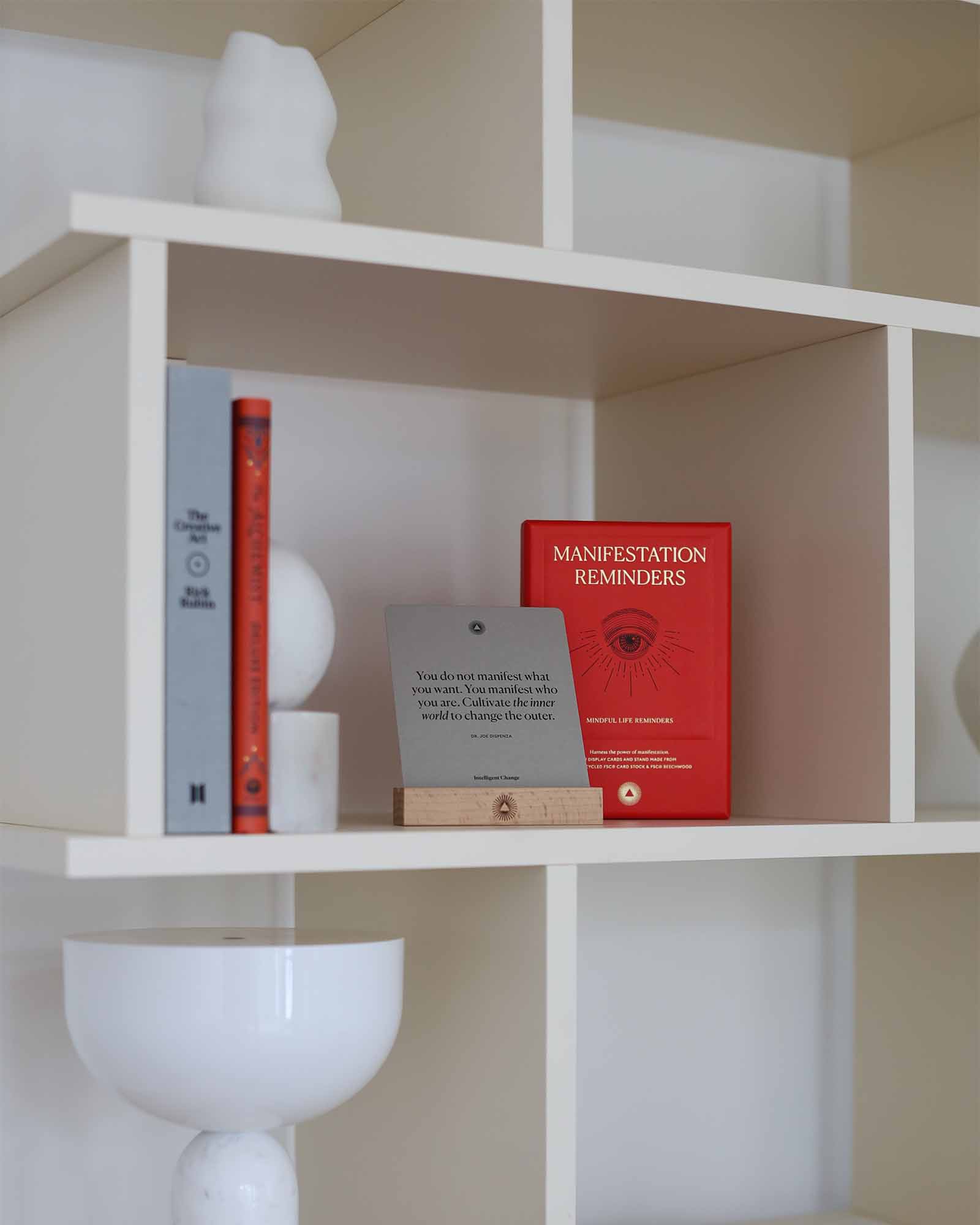5 Steps to Start Manifesting

Manifestation is a word that’s been stretched thin. It’s on your feed, in your podcasts, on book covers. It’s in stories about dream homes and serendipitous career breakthroughs. It’s linked to lucky girl syndrome and viral morning routines. And depending on who’s saying it, manifestation can sound like either a spiritual principle or a productivity hack.
And still, for many of us, it feels out of reach.
Or maybe because it’s hard to trust something that doesn’t come with immediate proof. You wish for something, try to do everything “right,” and when it doesn’t happen — or worse, the opposite does — it’s easy to lose faith. That’s where most people stop. But manifestation isn’t about control or timing.
So, it brings us to this question: What is manifestation, really? It’s not about wishful thinking. It’s not about controlling the universe. And it’s definitely not about “good vibes only” or ”fake it till you make it”.
Manifestation is about focus. It’s about making space for what matters, training your thoughts to reflect that, and taking steps, internally and externally, that support the life you’re working toward. It’s both inner work and outer effort. It’s a practice that builds clarity, trust, emotional strength, and direction over time.
The good news is that you don’t need the perfect moon phase to start manifesting. You don’t need to get it right on the first try. You don’t need to manifest your entire future by next Friday. You don’t even need to believe in it fully right now. What you need is intention, belief, and a willingness to show up, even when results don’t happen right away.
So, start where you are now and use what resonates. You can manifest inner peace. A more confident mindset. Better habits. Deeper relationships. Not everything has to be a mansion and a million-dollar business (but it can be, too, if that’s what you want).
Let’s break it down.
Step 1: Get clear on what you want and why
You can’t attract what you haven’t clarified.
Most people skip this step or make it vague:
I want a better life.
I want to be successful.
But manifestation begins with clarity. Be specific, but not rigid. Think of your mind like a GPS. If you type in a broad destination like "happiness," your route has no direction. But if you define what happiness actually looks like for you (more time in nature, deeper friendships, a creative outlet), now you’ve given your mind something to work with. Clarity reduces overwhelm. It makes the intangible real.
Ask yourself:
- What do I want more of in my life?
- What does success look like for me, not just what I see online?
- How do I want to feel as I move through my day?
Tip: Write it down in present tense, like it’s already happening.
I wake up feeling calm and grounded.
I am working on meaningful projects.
I trust myself to make aligned decisions.
Don’t simply chase outcomes. Connect to what those outcomes give you: freedom, confidence, purpose, stability.
Step 2: Train your mind to believe it’s possible
This is the part most people miss: the mindset work.
You say you want something, but a voice in your head whispers: ”You can’t have that.” That voice is often shaped by past experiences, fear of disappointment, or beliefs you picked up without questioning them. If you don’t believe it’s possible (or possible for you), your actions will reflect that. You’ll self-sabotage. You’ll procrastinate. You’ll settle.
One helpful practice? Start paying attention to your self-talk. Write down the limiting belief, then write down where you think it came from. Sometimes even identifying its origin takes away its power. Ask: Whose voice is this? Is it even mine?
This step isn’t about faking but about building mental resilience.
Tip: Use empowering, confidence-boosting affirmations that feel honest, not forced. Instead of “I am wildly successful,”try“I am learning to trust myself more every day.”
The goal isn’t to feel confident 24/7 or to fake it. It’s to build mental resilience and interrupt the limiting beliefs that keep you small. Over time, these affirmations become less of a script and more of a truth.
Your brain literally rewires through repetition and emotional engagement — it’s called neuroplasticity. And if you catch yourself spiraling into doubt or negativity, that’s not failure. It’s an invitation to pause and re-route your attention back toward possibility.
Step 3: Feel it in your body, not just your mind
This part might feel abstract, but it’s one of the most powerful tools you have: your emotions are part of your manifestation toolkit.
Here’s the science: your nervous system doesn’t fully differentiate between something vividly imagined and something real. So when you emotionally experience your future self, not just think about them, you’re helping your body and brain get used to that version of you.
Your thoughts and emotions directly impact your nervous system, which in turn influences your behavior. When you feel confident, peaceful, or excited about something, your brain releases signals that reinforce that experience and help you repeat it. It’s not enough to think about the life you want. You have to feel it. Not in a forced way, but in a way that helps your nervous system recognize this future as safe and familiar.
To make this tangible: set a 2-minute timer. Sit still. Close your eyes. Picture a moment in your future life. Maybe you’re giving a talk, signing a lease, traveling solo, hugging someone you love. Don’t just see it, feel it. How does your posture change? Are you calmer? More confident? What emotion would that version of you embody: freedom, peace, joy, pride? Let that emotion expand, even if it feels unfamiliar. Let your body practice it. This builds emotional familiarity and helps reduce self-sabotage when opportunities arise.
This is how you bridge the gap between imagination and reality. When your nervous system feels safe with your desires, you're more likely to act in alignment with them.
Step 4: Align your daily actions
You don’t manifest with your thoughts alone. You manifest with your choices.
This step isn’t about waiting for life to change, it’s actually choosing to show up like the person who’s already living that life.
The secret most manifestation advice skips: your habits build your reality. Thinking about your dream isn’t enough. What matters is whether you act like someone who believes in it, even in small, subtle ways. Your daily decisions — what you consume, who you talk to, how you spend your time — either reinforce your vision or delay it. This is what we call alignment.
Ask yourself each day:
- What is one small thing I can do today that aligns with my vision?
- What would the future version of me choose in this situation?
You don’t need to overhaul your life overnight. But you do need to move, even slowly, in the direction you want to go.
For example, if you want deeper relationships, text someone you miss and schedule a real catch-up; host a small dinner with no agenda; ask more meaningful questions in your existing conversations; say “I’m thinking of you” even when it feels random. Want to feel more confident? Speak up in a meeting; wear the outfit you’ve been saving; practice holding eye contact; try something new and let yourself be a beginner. Want to be more creative? Create for 30 minutes with no pressure to share it; unfollow accounts that trigger comparison; sign up for a class or workshop; turn your phone off and be bored on purpose.
Let your actions prove to your brain that the future you imagine is possible.
Step 5: Practice grounded gratitude
Gratitude is more than a mood booster, it’s a neurological reset. It shifts your brain out of survival mode and into a state of possibility.
Why does that matter for manifestation? Because you can’t create something new if you’re stuck in lack. Gratitude teaches your mind to notice what’s working, which makes it easier to build momentum and trust.
But we’re not talking about forced positivity or journaling “I’m grateful for my coffee” on autopilot. Grounded gratitude is specific. It’s felt. And it reminds you that you’re already living in alignment, even if it’s in small ways.
Here’s how to start:
- Instead of listing five things you're grateful for, write down one thing you’re grateful for and why it matters to you today.
- Celebrate something you once wished for, but now take for granted: your apartment, a friend, your current job, a second chance.
- When something doesn’t go your way, train your brain to ask: “What did I gain from this experience that I didn’t expect?”
- At the end of the week, reflect: Where in my life do I already feel the way I want to feel? That’s alignment.
Gratitude doesn’t mean you stop wanting more. It means you stop chasing it from a place of emptiness. And when you operate from a state of abundance and enough, of already having, your energy changes. You’re no longer waiting for life to complete you. You’re co-creating with it.
__________
Manifestation isn’t a one-time practice, but something you return to, again and again. A subtle shift in how you speak to yourself, how you move through the world, and what you believe is possible. That’s why visual reminders matter. A word. A quote. A moment of pause.
You don’t have to believe in magic. You just have to believe in possibility, and your role in shaping it.











